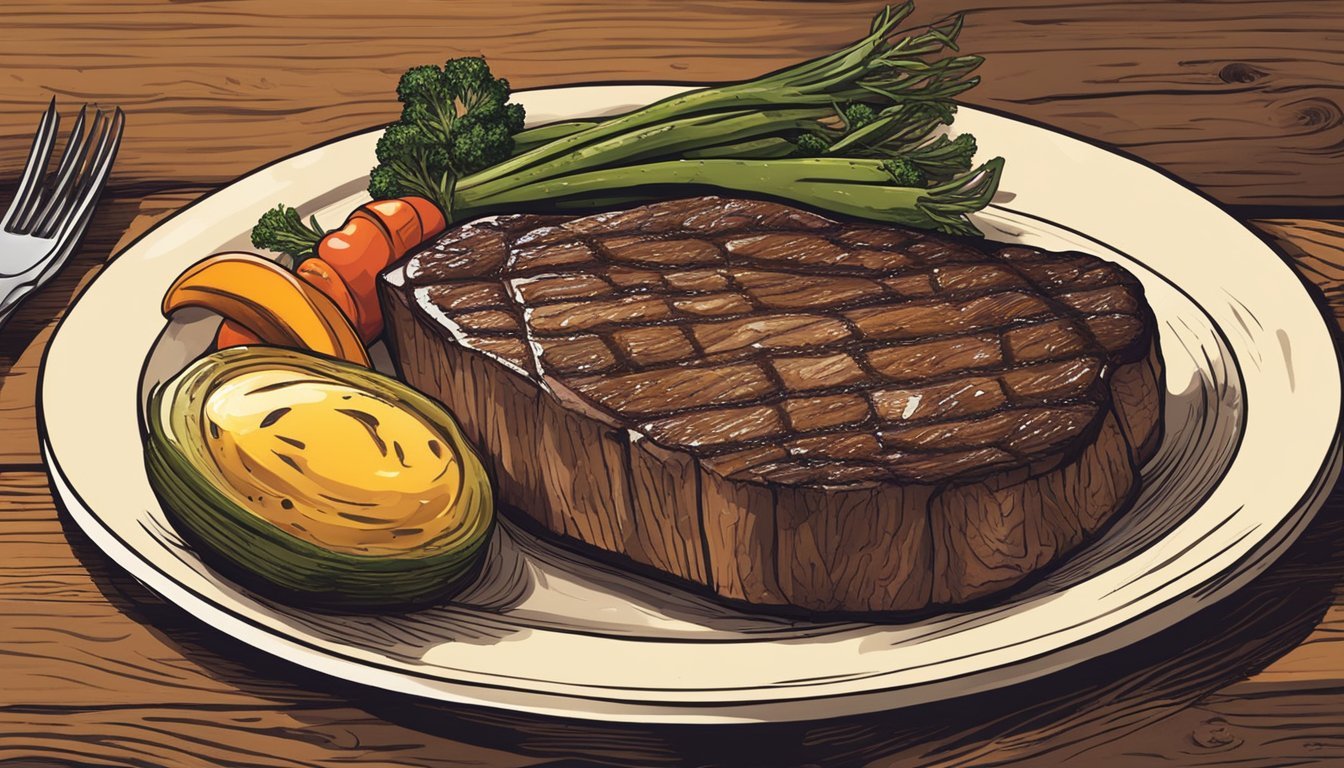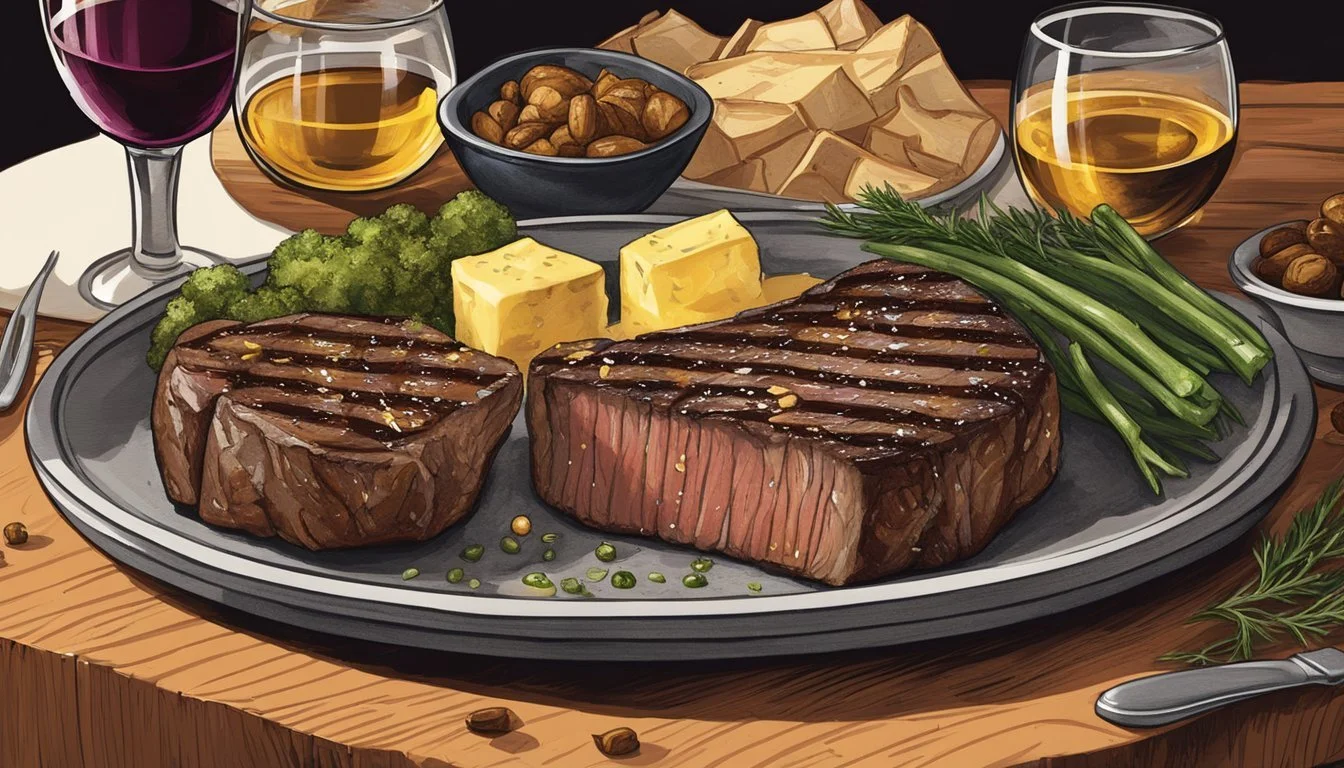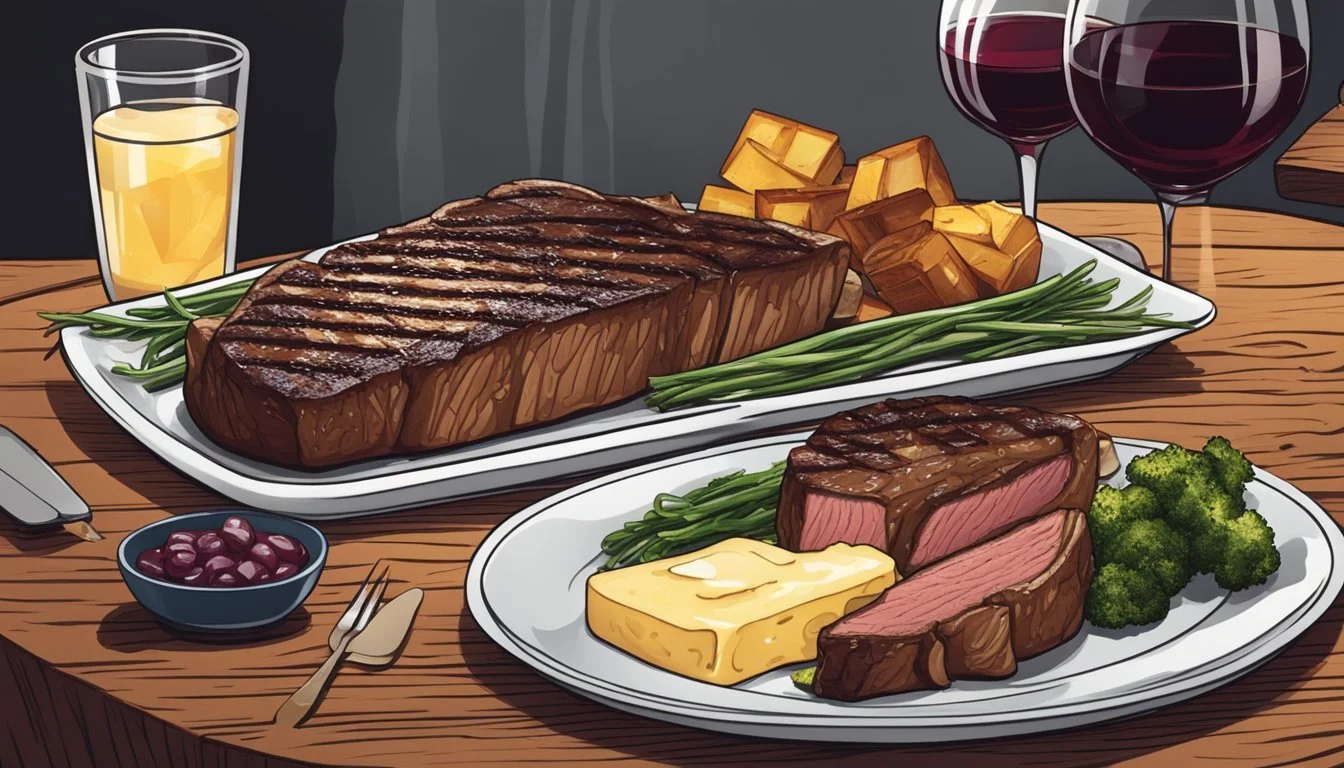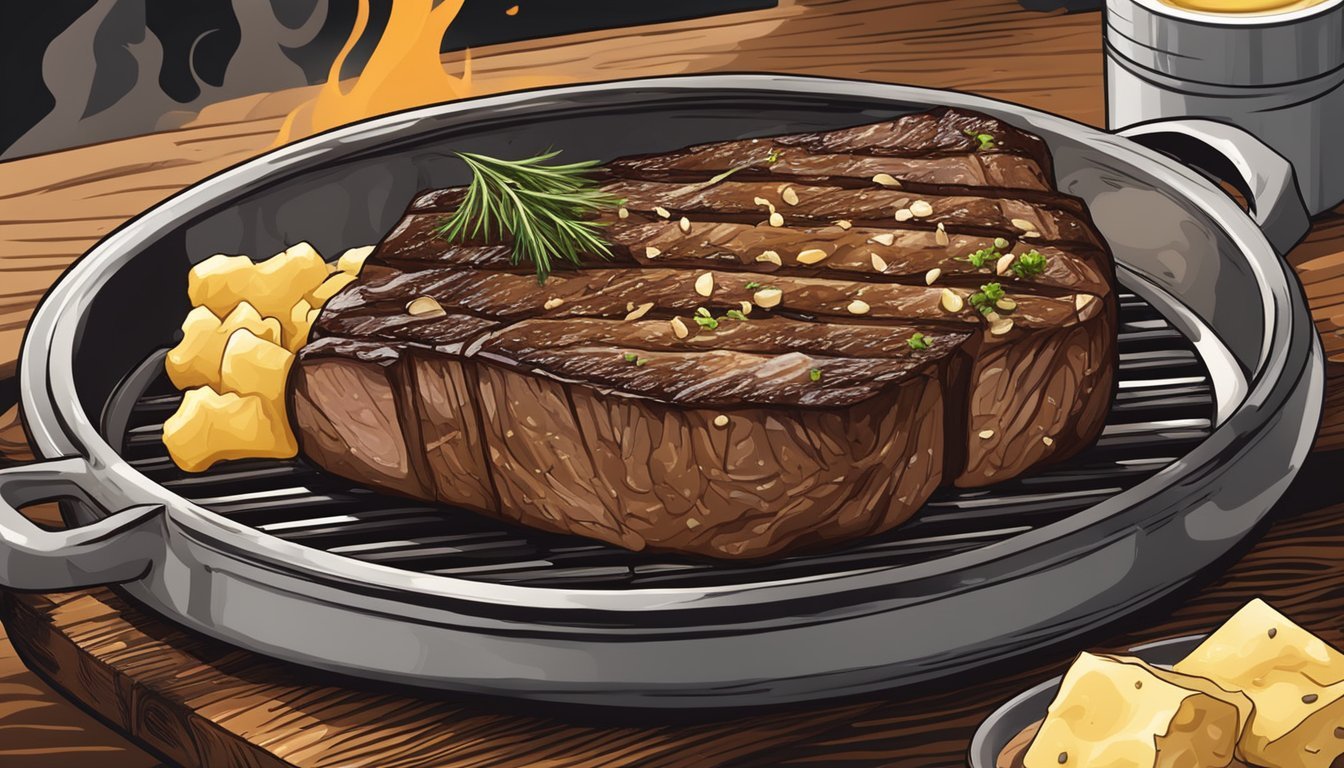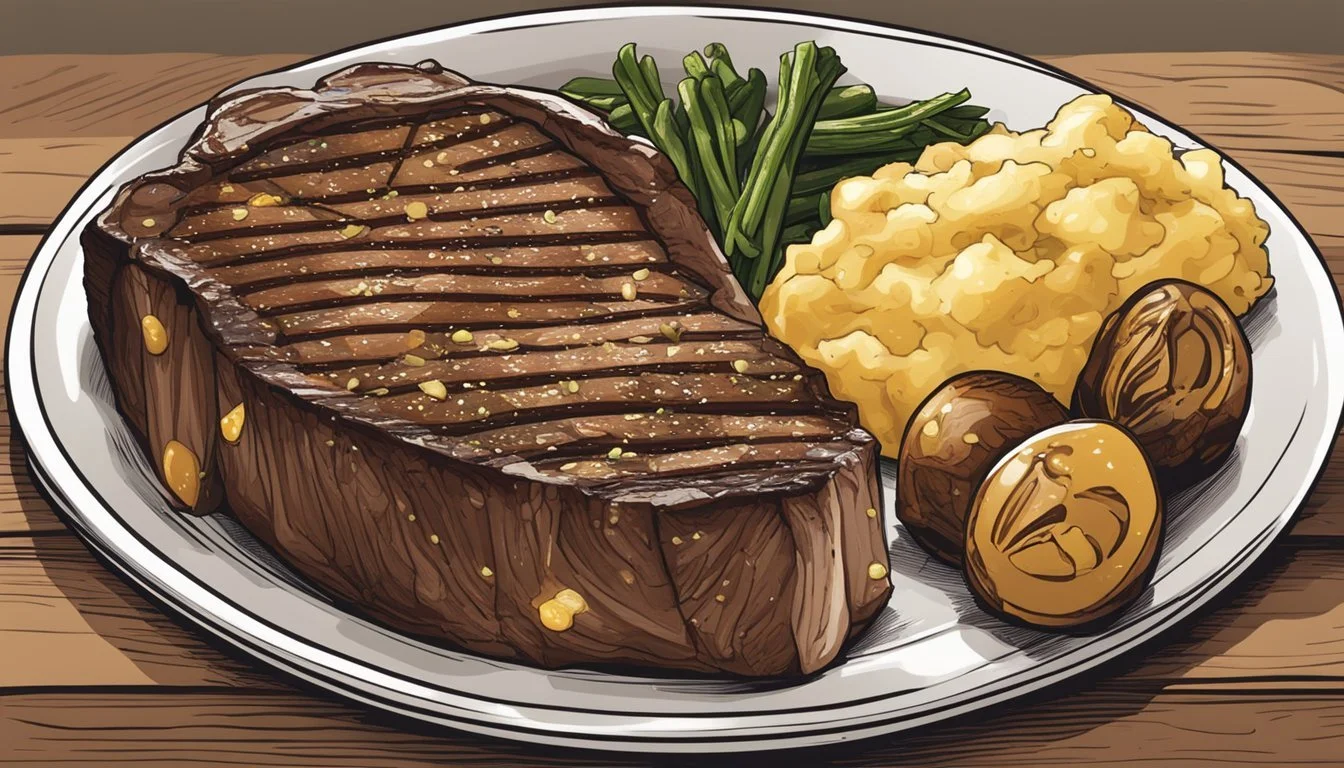Cowboy Butter Porterhouse Steak
Your Guide to a Flavorful Feast
Cowboy Butter Porterhouse Steak represents the epitome of hearty steakhouse fare, offering a symphony of flavors that transform a simple cut of beef into an impressive dinner (What wine goes well with dinner?) centerpiece. The dish elevates the traditional porterhouse—a steak known for its rich marbling and tender filet mignon and robust New York strip—to new heights with the addition of a decadent, herb-infused Cowboy Butter. The compound butter, flecked with garlic, spices, and citrus zest, melts over the sizzling steak, creating an aromatic and flavor-packed crust.
Crafting the perfect Cowboy Butter Porterhouse Steak requires a balance of technique and timing to ensure the steak is cooked to the preferred doneness while also allowing the Cowboy Butter to infuse the meat with its full-bodied flavors. The cooking process typically involves searing the steak to develop a savory crust and finishing it in the oven for even cooking. When the juicy steak is plated and topped with a generous dollop of the zesty Cowboy Butter, it becomes clear why this dish is a favorite for special occasions and weekend dinners alike.
Understanding Steak Selection
Selecting the right cut of meat is crucial to creating an unforgettable steak dinner. This section will guide you through understanding the specifics of choosing a porterhouse steak and ensuring its quality.
About Porterhouse Steak
Porterhouse steak is a luxurious cut that combines two coveted parts of the beef: the tenderloin and the top loin (better known as the New York Strip). Cut from the rear section of the short loin, the characteristic "T" shaped bone separates these two sections. When selecting a porterhouse, one should look for a steak that has a generous size—typically 1 1/2 inches thick—allowing for a savory and rich flavor profile. The presence of a larger tenderloin portion indicates a true porterhouse over a T-bone steak, which is smaller and less opulent.
Choosing Quality Beef
When it comes to the quality of beef, several factors determine its excellence:
Marbling: Look for even distribution of fat throughout the meat. This marbling enhances the steak's flavor and tenderness during cooking.
Grade of Beef: In the United States, beef is commonly graded as Prime, Choice, or Select. Prime grade is typically the most flavorful and tender, making it a preferred choice for a high-quality porterhouse.
Age of the Beef: Beef that has been appropriately aged will develop more flavor and tenderness. Dry aging is superior, although it may command a higher price.
Protein, like a porterhouse steak, when selected with care, will deliver a satisfying and hearty meal. Consider the degree of doneness preferred, as it will dictate the cooking time and temperature, ensuring the steak's savory qualities are perfectly showcased.
Essentials of Cowboy Butter
Cowboy butter elevates the steak-eating experience by combining rich butter with a robust blend of seasonings and herbs, creating a versatile condiment ideal for steak dipping or spreading.
Origin of Cowboy Butter
Cowboy butter, though not originating from any historical cowboy tradition, is a contemporary creation attributed to the spirit of American Western cuisine. It encapsulates bold flavors typical of the rugged, outdoor cooking style that one might romantically associate with cowboys of yesteryear.
Key Ingredients and Substitutes
Cowboy Butter Core Components:
Butter: The essential base, typically used softened to incorporate herbs and spices evenly.
Garlic: Freshly minced for a pungent kick.
Parsley: Freshly chopped for an earthy, herby note. Substitute with dried parsley if fresh is unavailable.
Lemon: Both juice and zest contribute a tangy freshness.
Black Pepper & Salt: For seasoning and balance.
Dijon Mustard: Adds a tangy depth. Whole grain mustard can be a substitute.
Cayenne: A pinch for some heat. Red pepper flakes are an alternative.
Optional Enhancements:
Additional herbs like thyme or chives can be introduced for complexity.
Spices such as paprika or chili to tailor the heat and flavor to individual tastes.
Creating cowboy butter requires mixing the aforementioned ingredients into softened butter, allowing their flavors to meld. The resulting compound butter can be reshaped and chilled into logs or used as a soft dip or condiment for sharing. It's essential to tailor the mix of fresh herbs or dried herbs and spices to one's personal preference while ensuring the butter remains the unifying base of the condiment.
Preparing the Steak
A porterhouse steak combines the juicy tenderness of a filet with the rich flavor of a New York strip. Keeping the steak preparation simple with a focus on proper marinating and cooking techniques ensures the meat’s natural flavors shine through with every bite.
Marinating and Seasoning
Marinating enhances the flavor of the porterhouse steak and adds a zesty undertone, which melds well with the rich, buttery sauce. A fundamental marinade includes:
Salt: Coarse kosher salt helps tenderize and flavor the steak deeply.
Pepper: Freshly ground black pepper adds a piquant note, perfectly complementing the steak's savoriness.
Garlic: Minced garlic creates a robust base for the steak’s seasoning profile.
Lemon Juice: The acidity of lemon juice tenderizes the steak and gives it a bright flavor.
Paprika and Cayenne Pepper: These spices contribute a warm and slight spicy kick to the steak, rounding out the taste.
Ensure even coverage of the seasoning:
Pat the steak dry with paper towels.
Season liberally with kosher salt and freshly ground black pepper.
Rub the steak with minced garlic, paprika, and a pinch of cayenne pepper.
Drizzle lemon juice over the steak.
Marinate for at least 30 minutes, or longer for deeper flavor.
Cooking Techniques
The method used to cook the steak is crucial for achieving a perfectly caramelized crust without overlooking the interior. Two popular approaches are:
Oven Searing: Preheat the oven with a cast iron skillet inside to achieve a high initial cooking temperature that crisps the exterior of the porterhouse quickly.
Using a Meat Thermometer: This tool is invaluable for monitoring the steak’s internal temperature, avoiding guesswork, and ensuring the desired level of doneness is reached.
Steps for Oven Searing:
Preheat the oven to 425°F (220°C) with the cast iron skillet inside.
Once hot, place the steak in the skillet and sear on one side until a dark crust forms, about 4 minutes.
Flip the steak and transfer the skillet back to the oven, cooking to the desired doneness—use a meat thermometer to check.
Grilled Steak Option: For a grilled steak:
Preheat the grill to a high temperature.
Grill each side to create sear marks.
Move the steak to a lower heat area and finish cooking to the desired internal temperature.
In both methods, let the steak rest for a few minutes before slicing to allow the juices to redistribute, ensuring a moist and flavorful steak.
Making Cowboy Butter
Cowboy butter is a bold condiment that enhances the flavors of steak, with a mixture of herbs, spices, and tangy lemon zest. These mixing instructions will guide you to preparing this zesty butter, followed by advice on achieving the ideal consistency and tips for storage.
Mixing Instructions
Begin by placing 1 cup of softened butter (salted or unsalted, based on preference) in a mixing bowl. Add 2 tablespoons fresh lemon juice, 1 teaspoon of lemon zest, 2 cloves of minced garlic, and 2 teaspoons Dijon mustard for a layer of tangy complexity. Incorporate a pinch of cayenne pepper for heat and 1 tablespoon of red pepper flakes if you enjoy a spicy kick.
Continue by mixing in a quarter cup each of finely chopped parsley and fresh chives, which rounds out the flavor with herbaceous notes. Whisk the mixture until all ingredients are well incorporated into the butter. For seasoning, sprinkle in kosher salt to taste.
Ingredients:
1 cup softened butter
2 tbsp fresh lemon juice
1 tsp lemon zest
2 minced garlic cloves
2 tsp Dijon mustard
Pinch of cayenne pepper
1 tbsp red pepper flakes
1/4 cup finely chopped parsley
1/4 cup finely chopped fresh chives
Kosher salt, to taste
Ideal Consistency and Storage
The ideal consistency for cowboy butter is smooth yet firm enough to hold its shape when cooled. After mixing, the butter can be placed on a sheet of plastic wrap, formed into a log, and rolled tightly. Store it in the refrigerator to firm up for about 30 minutes before slicing.
For long-term storage, cowboy butter can be kept in an airtight or sealed container. In the refrigerator, it will stay fresh for up to 2 weeks. If you opt to freeze it, cowboy butter can last for several months, ensuring its rich flavor is preserved. When you're ready to use it, simply thaw it in the fridge.
Maintain the quality of the cowboy butter by storing it in the colder part of the refrigerator, away from the door, which is subject to more temperature fluctuations. Whether you choose salted or unsalted butter, ensure it is of high quality to contribute to the overall richness of the condiment.
Serving and Pairing Ideas
Creating the perfect Cowboy Butter Porterhouse Steak dinner is as much about the main dish as it is about the carefully chosen accompaniments and beverages that enhance its flavors.
Accompaniments for Porterhouse Steak
The Cowboy Butter Porterhouse Steak pairs exquisitely with a variety of side dishes. For a burst of freshness and a touch of elegance, parsley can be finely chopped and sprinkled over the steak or incorporated into the Cowboy Butter for an herbed finish.
Potatoes make for a classic companion, offering several preparation options:
Mashed Potatoes: Creamy and smooth, these are perfect for soaking up the steak's juices and Cowboy Butter.
Roasted Potatoes: Crispy on the outside and soft on the inside, they provide a satisfying textural contrast to the steak.
For veggies, consider the following:
Roasted Broccoli: Its crisp edges and tender stalks make it an excellent side, absorbing the rich flavors of the Cowboy Butter.
Sautéed Green Beans: Lightly seasoned and tossed in olive oil, they add a crisp, contrasting texture.
Roasted Carrots: Their natural sweetness complements the savory depth of the porterhouse and butter.
Finally, bread, like a crusty baguette, can be served to mop up any remaining butter on the plate.
Wine and Beverage Pairings
The ideal beverage pairing can elevate the steak dinner experience. For wine enthusiasts, a bold red wine makes an excellent match with the hearty flavors of the porterhouse steak. Here are some optimal choices:
Cabernet Sauvignon: Its full-bodied nature and tannic structure stand up well to the richness of the steak.
Malbec: Known for its dark fruit flavors and smoky finish, it complements the charred exterior of the steak.
For non-alcoholic options, a sparkling water with a slice of lemon can cleanse the palate between bites, ensuring each mouthful is as enjoyable as the first.
Additional Serving Suggestions
When crafting a meal around Cowboy Butter Porterhouse Steak, one must consider complementary dishes that highlight the rich and savory flavors of the butter. The versatility of Cowboy Butter allows it to pair effortlessly with a variety of foods, enhancing the dining experience.
Ideas Beyond Steak
Cowboy Butter isn't just for steak; it can enhance many other proteins with its bold taste. Here are several ways to incorporate this flavorful condiment into other dishes:
Chicken: Brush Cowboy Butter on grilled or roasted chicken to add a kick of flavor.
Pork: A pork chop or tenderloin can benefit from drizzling or dolloping Cowboy Butter atop the finished dish.
Seafood: Seafood such as shrimp and fish fillets can be transformed with a spoonful of Cowboy Butter, either as a dip or a sautéed enhancement.
Considering vegetables, Cowboy Butter serves as an exceptional addition, bringing a savory intensity to otherwise mild flavors:
Roasted Vegetables: Toss vegetables in melted Cowboy Butter before roasting for a deep, roasted taste.
Sautéed Greens: Finish sautéed greens with a dollop of Cowboy Butter for an extra layer of richness.
Breads such as dinner rolls or cornbread are ideal for sharing and can be made more indulgent when served with Cowboy Butter as a spread.
Creating a Themed Dinner
To create a themed dinner where Cowboy Butter is the star, one can curate recipes that allow the Cowboy Butter to shine as a key component across all the courses:
Appetizer: Offering a Cowboy Butter dipping station with a medley of bread, from rustic loaves to soft dinner rolls, invites guests to indulge from the very beginning.
Main Course: The Porterhouse Steak, lavished with Cowboy Butter, stands as the centerpiece amidst the dinner options.
Sides: Accompany the steak with sides that can also embrace the buttery magic; think buttered cornbread or Cowboy Butter-brushed corn on the cob.
Repurposing leftovers becomes an enjoyable challenge, as Cowboy Butter adds a twist to the next day's meals—think sandwiches or wraps with a Cowboy Butter spread inside.
Alternate Uses for Cowboy Butter
Cowboy butter, a flavorful condiment teeming with spices and herbs, elevates more than just steaks. Its rich and zesty profile enriches a variety of dishes, transforming everyday meals into gourmet experiences. Whether used as a spread, flavor enhancer, or a versatile touch to breakfast, cowboy butter’s bold taste imparts a distinctive twist.
Spicy Steak Sandwich Spread
Cowboy butter serves as an excellent spread that can turn a simple steak sandwich into a spicy and savory delight. The blend of garlic, fresh parsley, chives, and lemon juice paired with a hint of heat from chili flakes gives a spicy steak sandwich an irresistible zest. Adding a tablespoon of cowboy butter on warm, toasted bread as a steak sauce alternative can pleasantly surprise the palate.
Ingredients:
Cowboy butter
Bread
Cooked steak slices
Optional: Horseradish for extra heat
Instructions:
Spread a generous layer of cowboy butter on warm, toasted bread.
Place the cooked steak slices on the bread.
Add an optional dab of horseradish for an extra spicy kick.
Flavoring Agent for Side Dishes
Cowboy butter isn't reserved for meat alone; it splendidly flavors side dishes such as vegetables and potatoes. Stir a spoonful of this compound butter into cooked vegetables or mix it with mashed potatoes for a touch of zesty cilantro and tangy lemon. The harmonious blend of spices and lemon zest can easily replace plain butter or other condiments, infusing sides with a unique and appetizing twist.
Side Dish Recommendations:
Mashed potatoes
Grilled or steamed vegetables
Corn on the cob
Application:
Melt a dollop of cowboy butter.
Drizzle or fold into your chosen side dish.
Serve immediately, garnished with extra parsley if desired.
Enhancing Breakfast Favorites
Breakfast favorites receive a flavor boost from cowboy butter. Whisk a dollop into scrambled eggs or spread on fresh toast for an enhanced morning experience. The garlic and herbs in cowboy butter bring a new dimension to traditional breakfast dishes, while a squeeze of lemon juice brightens the overall profile.
Breakfast Ideas:
Scrambled eggs
Toast
Omelets
Method:
Add cowboy butter to eggs before cooking for a richer flavor.
Spread over toast as a zesty alternative to plain butter.
Recipe Variations
When crafting a Cowboy Butter Porterhouse Steak, personal preferences or dietary needs can be accommodated with a few thoughtful modifications to the herbs, spices, and overall recipe composition. These changes can still yield a luscious and flavor-packed steak dinner.
Herb and Spice Adjustments
Herbs: The classic Cowboy Butter recipe incorporates chives, parsley, and occasionally thyme. However, personal taste may dictate the inclusion of other herbs such as:
Rosemary for its fragrant and woodsy touch.
Cilantro for a fresh, citrusy kick.
Basil for a sweet and peppery flavor.
Spices: Adjusting the heat and spiciness can easily be tailored to individual palates. Consider:
Increasing or decreasing chili flakes based on heat preference.
Using dried herbs if fresh ones aren’t available; be mindful that dried herbs are more potent, so use them sparingly.
To modify, start with small increments of each new herb or spice, tasting as one goes, to avoid overpowering the dish.
Diet-Specific Alternatives
Dairy-Free: Replace butter with alternatives such as:
Olive oil or avocado oil, for their healthy fats and high smoke points.
Dairy-free butter substitutes, which maintain a similar texture and can be used in the same quantities as regular butter.
Gluten-Free: Ensure all ingredients used are certified gluten-free, including any sauces or seasonings. The intrinsic Cowboy Butter recipe is naturally gluten-free, but always double-check ingredient labels for any hidden gluten.
Remember, these adjustments should maintain the integrity of the recipe while making it suitable for various dietary preferences.
Food Safety and Storage
When preparing a Cowboy Butter Porterhouse Steak, food safety and storage are essential to prevent foodborne illness and maintain the quality of the ingredients. Handling raw meat safely and storing the rich Cowboy Butter appropriately will ensure that the flavors are preserved and the meal remains safe for consumption.
Proper Handling of Raw Meat
One must always wash their hands thoroughly before and after handling raw steak to avoid cross-contamination. Using a meat thermometer to check that the internal temperature of the beef reaches a safe 145°F (63°C) for medium rare ensures it's cooked properly. After use, utensils and surfaces should be cleaned with hot soapy water. Below is a step-by-step guide for handling raw meat:
Step 1: Begin by washing hands with warm water and soap for at least 20 seconds.
Step 2: Prepare raw meat on a separate cutting board to avoid cross-contamination.
Step 3: Utilize a clean meat thermometer to check internal temperatures.
Step 4: Once finished, clean all contact surfaces and utensils with hot, soapy water.
Storing and Reusing Cowboy Butter
The remaining Cowboy Butter should be stored in the refrigerator and used within one week. For longer storage, it can be frozen in an airtight or sealed container. Here's a succinct guide to store leftover butter:
Storage Location Container Type Maximum Storage Time Refrigerator Airtight Container 1 Week Freezer Sealed Container Up to 3 Months
If frozen, Cowboy Butter should be thawed in the refrigerator before reuse. When reusing, one must ensure that the butter has not developed any off smells or discoloration, indicating spoilage.
Conclusion
The Cowboy Butter Porterhouse Steak stands out as a hearty meal, combining the richness of a well-marbled steak with the bold flavors of Cowboy Butter. The Porterhouse cut offers diners two experiences in one: the tender filet and the flavorful New York strip. This steak satisfies even the most robust appetites and is suitable for a range of occasions, from casual family dinners to more formal gatherings.
Emphasizing simplicity and quality, the key to this dish lies in the careful preparation of both the butter and the steak. The Cowboy Butter, with its mixture of herbs, spices, and citrus, provides a complementary kick of flavor that enhances the steak without overpowering its natural savoriness.
To achieve the best results, chefs should:
Season the steak generously with salt and pepper.
Cook to the desired level of doneness, aiming for a crisp crust.
Rest the steak adequately before serving to ensure proper juice retention.
Serve with a dollop of Cowboy Butter, allowing it to melt enticingly over the meat.
In summary, this entree is as impressive on the plate as it is satisfying on the palate. It reflects a balance between rustic charm and culinary finesse, making it an ideal choice for those seeking to serve a memorable and delicious meal.
Appendix: Additional Resources
In this section, readers will find curated resources to expand their knowledge of Cowboy Butter Porterhouse Steak. These include test kitchens for verified recipes and insights into how this dish trends on social media.
Online Test Kitchens and Reviews
Test kitchens are vital for perfecting recipes, and many websites feature test kitchen-approved Cowboy Butter Porterhouse Steak directions. Serious Eats and America's Test Kitchen offer scientifically tested recipes, ensuring the right techniques for preparing the steak to perfection. They also host reviews, where home cooks can learn from others' experiences.
Readers should look for reviews that detail texture, flavor, and overall success of the recipes. These will guide them in selecting a recipe that has been tried and tested by a community of cooks, and potentially avoid common pitfalls encountered by others.
Viral Trends and Social Media
Platforms like TikTok and Instagram have become hotspots for sharing and discovering food trends. Cowboy Butter Porterhouse Steak has had its moments of virality, where users share their takes on the dish. These platforms can offer a real-time look at how people are adapting and serving their steaks.
Examples of Social Media Trends for Cowboy Butter Porterhouse Steak:
TikTok hashtags: #CowboyButterSteak, #SteakTrend, #CookingTips
Instagram posts of plated Cowboy Butter Steaks with vibrant sides
Viewers can browse these tags to observe how others serve and enjoy Cowboy Butter Porterhouse Steak, often leading them to new and inventive recipes. It also encourages home chefs to share their creations, joining the online community of steak enthusiasts.
Frequently Asked Questions
What is a porterhouse steak? A porterhouse steak is a large, flavorful cut of beef that comes from the rear end of the short loin. It includes a sizeable portion of tenderloin on one side and a New York strip on the other side. They are known for their generous size and rich flavor.
How should porterhouse steaks be cooked for optimal flavor? They should be seasoned well and cooked using a method that produces a rich, caramelized crust while maintaining the desired level of doneness on the inside. Many opt to sear steaks in a hot cast iron skillet, then finish them in the oven.
Doneness Internal Temperature Rare 120-125°F (49-52°C) Medium-Rare 130-135°F (54-57°C) Medium 140-145°F (60-63°C) Medium-Well 150-155°F (65-68°C) Well Done 160°F (71°C) and above
What is cowboy butter? Cowboy butter is a type of compound butter infused with herbs, spices, and occasionally citrus zest. It melts beautifully over hot meats and enhances the savory flavors of the dish.
How is compound butter different from regular butter? Compound butter is regular butter that has been mixed with flavorings such as garlic, herbs, and spices. It adds depth and richness to dishes and can be shaped into rolls and chilled for convenient use.
Can porterhouse steaks be cooked on the stovetop? Yes, porterhouse steaks can be cooked on the stovetop. It’s best to use a cast iron skillet for its even heating and ability to retain high temperatures, which are ideal for achieving a well-seared crust.
About the Author
The author, an accomplished culinary writer, brings to the table a deep-seated passion for gastronomy and a wealth of experience from years in various test kitchens. Their expertise extends from creating mouthwatering dinner rolls to crafting intricate main courses, exemplified by the robust Cowboy Butter Porterhouse Steak recipe that they have perfected.
Experience:
Spent several years in high-end restaurant test kitchens.
Has developed and tested numerous recipes for both digital and print publications.
Specialty:
Known for melding traditional methods with modern twists.
Excels in explaining complex cooking techniques in an accessible way.
Culinary Philosophy: The author believes in using high-quality ingredients and exacting methods to achieve restaurant-quality results at home. Their approach is straightforward and detail-oriented, ensuring that even novice cooks can follow along with confidence.
Signature Dishes:
Cowboy Butter Porterhouse Steak: A testament to their innovation in the kitchen.
Homemade Dinner Rolls: A recipe beloved for its fluffiness and rich flavor.
Each recipe developed by the author reflects their commitment to clear, approachable instructions. They advocate for the importance of accuracy in cooking, knowing that it is the key to replicating the intended dining experience. Loyal readers trust the author's recipes because, beyond their professional background, they share a common goal: making memorable meals accessible to every home cook.

